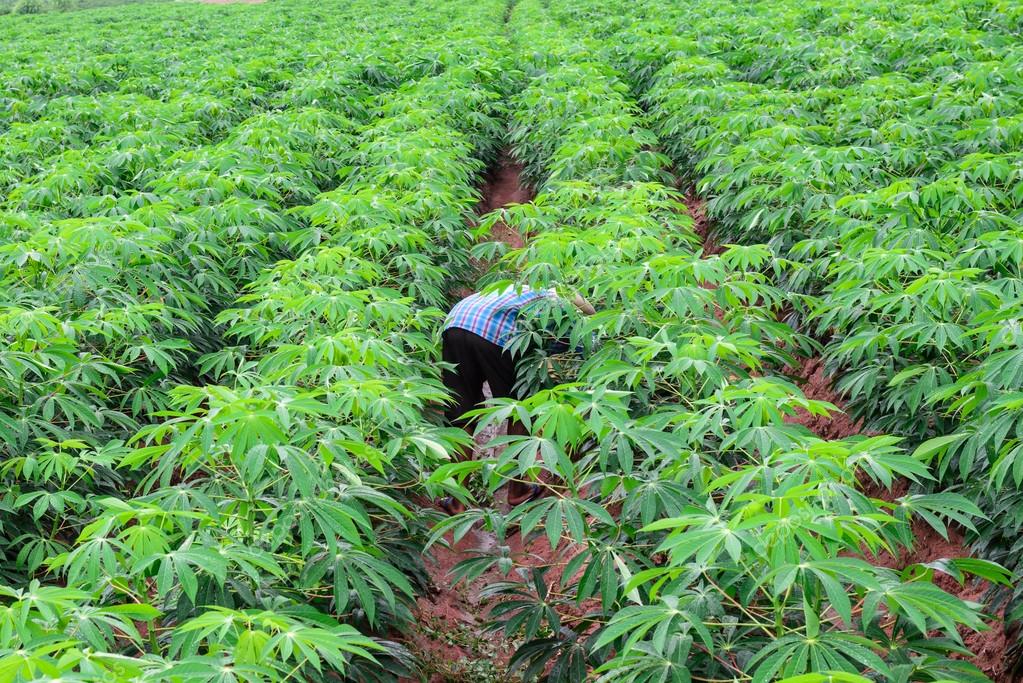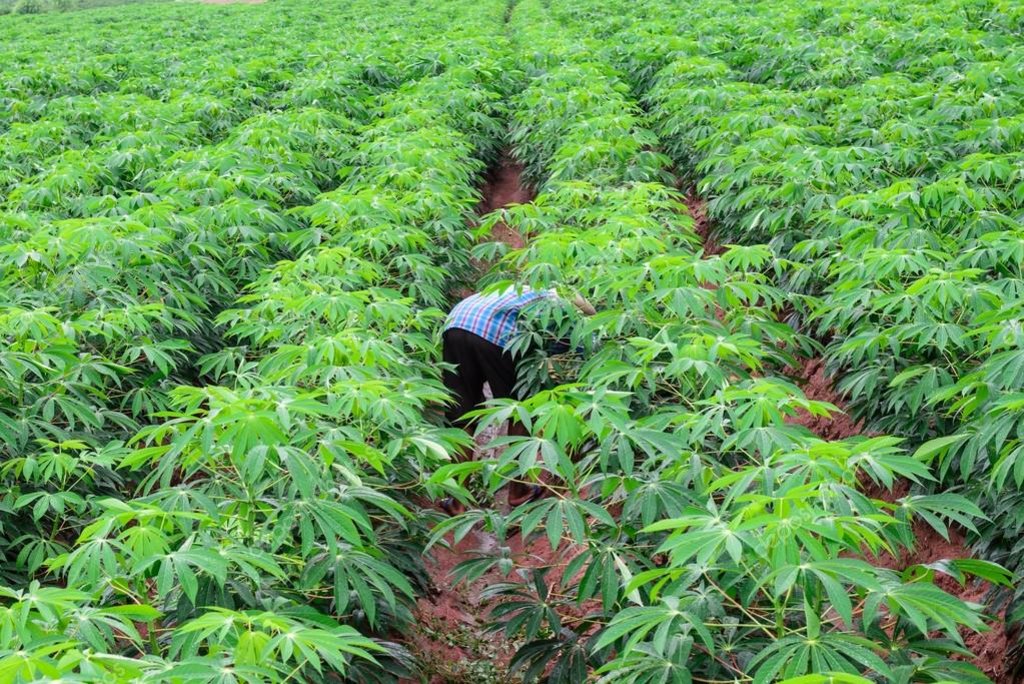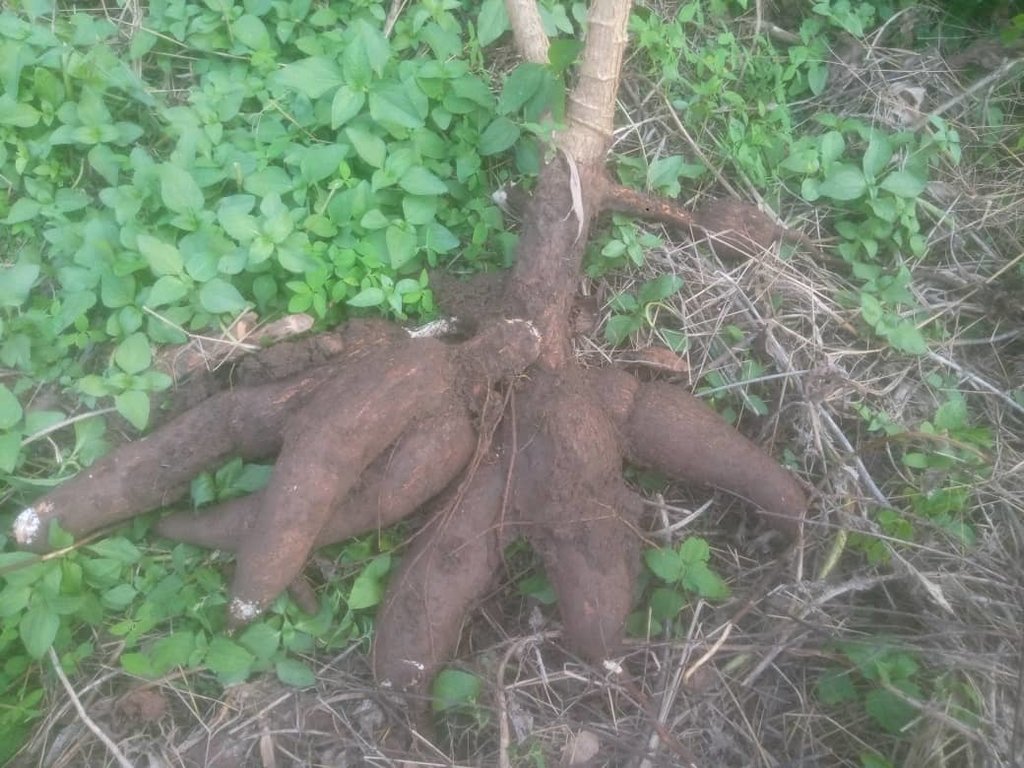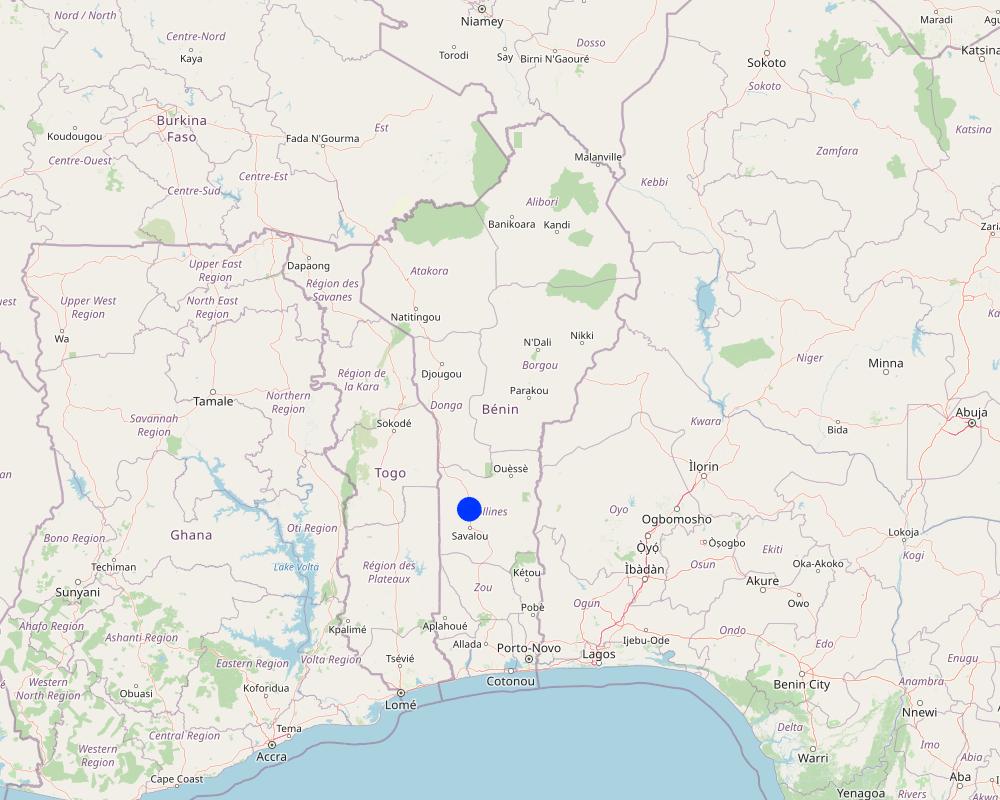Production of Cassava - a Drought Tolerant Crop [Benin]
- Creation:
- Update:
- Compiler: Gatien AGBOKOUN CHRISTOPHE
- Editors: Siagbé Golli, Abdoul Karim MIEN, DOSSOU-YOVO bernardin, Oscar Assa KINDEMIN, Bona Ibouratou DAFIA, Tabitha Nekesa, Ahmadou Gaye
- Reviewers: Sally Bunning, Rima Mekdaschi Studer, William Critchley
Kpaki
technologies_6679 - Benin
View sections
Expand all Collapse all1. General information
1.2 Contact details of resource persons and institutions involved in the assessment and documentation of the Technology
Key resource person(s)
land user:
OLOU Rufine
CRADIB ONG
Benin
SLM specialist:
SEGNONAN Expédit
CRADIB ONG
Benin
SLM specialist:
GBEGNON Rokard
CRADIB ONG
Benin
Name of project which facilitated the documentation/ evaluation of the Technology (if relevant)
Soil protection and rehabilitation for food security (ProSo(i)l)Name of the institution(s) which facilitated the documentation/ evaluation of the Technology (if relevant)
GIZ Bénin (GIZ Bénin) - Benin1.3 Conditions regarding the use of data documented through WOCAT
The compiler and key resource person(s) accept the conditions regarding the use of data documented through WOCAT:
Yes
1.4 Declaration on sustainability of the described Technology
Is the Technology described here problematic with regard to land degradation, so that it cannot be declared a sustainable land management technology?
No
2. Description of the SLM Technology
2.1 Short description of the Technology
Definition of the Technology:
Production of cassava (Manihot esculenta) helps to address drought and improves food security.
2.2 Detailed description of the Technology
Description:
Cassava (Manihot esculenta) is a shrub that produces an abundance of nutritious leaves, and large tubers rich in carbohydrates (starch) and is gluten-free. However, it requires nine months of vegetal development.
The technology used to grow drought-tolerant crops such as cassava is applied to flood-free arable lands. Cassava is best grown in sandy loam soils (made up of silt and sand) or sandy clay soil (made up of clay and sand). In other words, it thrives in permeable, deep soils rich in organic matter, ideally flat or gently sloping. The soil needs to be worked to a depth of at least 20 cm to create ridges or mounds of loosened soil to cover the roots as they develop and ensure good drainage.
This technology is designed to:
- guarantee reliable food production in drought conditions;
- control rainwater to facilitate soil drainage and aeration while preventing flooding;
- enhance air circulation within the soil.
When selecting plant materials, cuttings are taken from the central part of the stem. These cuttings are collected from freshly harvested stems aged between 12 to 18 months, specifically from the portion of the stem where the cross-section exhibits a diameter equal to or greater than twice the diameter of the central part. It is strongly recommended that cuttings already infected with pathogens and pests be avoided, as most cassava diseases and pests are transmitted by cuttings. To breed improved varieties, producers sometimes opt to purchase cuttings. To mitigate the risk of losing cuttings, producers immerse them either in hot water at 50°C for 15 minutes or in a pesticide solution (a mixture of fungicide and insecticide) to kill insects adhering to the cuttings and reduce the incidence of anthracnose.
For one hectare, approximately 8,350 cuttings are needed, with a spacing of 1 meter between planting units and 1.2 meters between rows. Growers conduct maintenance operations focusing on the following aspects:
- Plant replacement: dead or weak seedlings or seedlings showing signs of disease (dwarfing, white, yellow colour, mosaic, etc.) are identified, pulled out and replaced by new cuttings
- Weeding: the producers carry out three mandatory weeding operations, 3 to 4 weeks, 7 to 9 weeks and 12 to 14 weeks after performing the cuttings, to make sure the seedlings grow properly and are protected from rodents and other pests
The harvest, typically conducted between the 9th and 18th month, has the potential to reach 35 tons per hectare, demanding significant labour and transportation efforts.
2.3 Photos of the Technology
2.5 Country/ region/ locations where the Technology has been applied and which are covered by this assessment
Country:
Benin
Region/ State/ Province:
Bantè / Donga
Specify the spread of the Technology:
- evenly spread over an area
If the Technology is evenly spread over an area, specify area covered (in km2):
1.0
Is/are the technology site(s) located in a permanently protected area?
No
Map
×2.6 Date of implementation
If precise year is not known, indicate approximate date:
- more than 50 years ago (traditional)
2.7 Introduction of the Technology
Specify how the Technology was introduced:
- as part of a traditional system (> 50 years)
Comments (type of project, etc.):
Cassava has been grown for decades. However, the efforts of ProSOL have brought increased attention to cassava cultivation as a climate change adaptation strategy.
3. Classification of the SLM Technology
3.1 Main purpose(s) of the Technology
- improve production
- reduce risk of disasters
- adapt to climate change/ extremes and its impacts
- create beneficial economic impact
- create beneficial social impact
3.2 Current land use type(s) where the Technology is applied
Land use mixed within the same land unit:
No

Cropland
- Perennial (non-woody) cropping
- Cassava
Number of growing seasons per year:
- 1
Specify:
Its vegetative cycle generally lasts between 12 and 18 months.
3.3 Has land use changed due to the implementation of the Technology?
Has land use changed due to the implementation of the Technology?
- Yes (Please fill out the questions below with regard to the land use before implementation of the Technology)
Land use mixed within the same land unit:
No

Cropland
- Annual cropping
Annual cropping - Specify crops:
- cereals - maize
- cereals - sorghum
Is crop rotation practiced?
Yes
If yes, specify:
Maize, squash, sorghum
3.4 Water supply
Water supply for the land on which the Technology is applied:
- rainfed
3.5 SLM group to which the Technology belongs
- improved ground/ vegetation cover
- integrated soil fertility management
3.6 SLM measures comprising the Technology

agronomic measures
- A1: Vegetation/ soil cover
- A2: Organic matter/ soil fertility

vegetative measures
- V1: Tree and shrub cover

management measures
- M1: Change of land use type
3.7 Main types of land degradation addressed by the Technology

water degradation
3.8 Prevention, reduction, or restoration of land degradation
Specify the goal of the Technology with regard to land degradation:
- reduce land degradation
- adapt to land degradation
4. Technical specifications, implementation activities, inputs, and costs
4.1 Technical drawing of the Technology
Technical specifications (related to technical drawing):
Cuttings must be taken from the central part of the stem. Ideally, these cuttings should be sourced from freshly harvested stems aged between 12 to 18 months, specifically from the portion of the stem where the cross-section demonstrates a diameter equal to or greater than twice the diameter of the central soft part. Alternatively, healthy cuttings could be purchased from research or extension institutions. It is strongly advised not to use cuttings that have already been infected by pathogens and pests, as most cassava diseases and pests are transmitted through cuttings.
The selected stems should be cut with a sharp knife into 15-20 cm long cuttings, each containing at least 5 nodes. The end of the stem should not be used to make cuttings. Additionally, it is advisable to soak the cuttings either in hot water at 50°C for 15 minutes or in a pesticide solution (a mixture of fungicide and insecticide) to eliminate insects adhering to the cuttings and reduce the incidence of anthracnose.
For one hectare, approximately 8,333 cuttings are required, with a spacing of 1 meter between planting units and 1.2 meters between rows. During planting, 2/3 of the cuttings should be planted at a 70° angle to the horizontal in an east-west direction.
4.2 General information regarding the calculation of inputs and costs
Specify how costs and inputs were calculated:
- per Technology area
Indicate size and area unit:
1h
Specify currency used for cost calculations:
- USD
If relevant, indicate exchange rate from USD to local currency (e.g. 1 USD = 79.9 Brazilian Real): 1 USD =:
613.0
Indicate average wage cost of hired labour per day:
2500
4.3 Establishment activities
| Activity | Timing (season) | |
|---|---|---|
| 1. | Clearing | Mach-April |
| 2. | Ploughing/Ridging | May-June |
| 3. | Purchase of cuttings | June |
| 4. | Planting | June-July |
4.4 Costs and inputs needed for establishment
| Specify input | Unit | Quantity | Costs per Unit | Total costs per input | % of costs borne by land users | |
|---|---|---|---|---|---|---|
| Labour | Clearing | ha | 1.0 | 17500.0 | 17500.0 | 100.0 |
| Labour | Ploughing/Ridging | ha | 1.0 | 24000.0 | 24000.0 | 100.0 |
| Labour | Planting | ha | 1.0 | 50000.0 | 50000.0 | 100.0 |
| Plant material | Purchase of cuttings | ha | 1.0 | 50000.0 | 50000.0 | 100.0 |
| Total costs for establishment of the Technology | 141500.0 | |||||
| Total costs for establishment of the Technology in USD | 230.83 | |||||
4.5 Maintenance/ recurrent activities
| Activity | Timing/ frequency | |
|---|---|---|
| 1. | Cutting | July |
| 2. | Clearing | July |
| 3. | Firebreak | December-January |
| 4. | Harvest | February-June |
4.6 Costs and inputs needed for maintenance/ recurrent activities (per year)
| Specify input | Unit | Quantity | Costs per Unit | Total costs per input | % of costs borne by land users | |
|---|---|---|---|---|---|---|
| Labour | Cutting | ha | 1.0 | 10000.0 | 10000.0 | 100.0 |
| Labour | Firebreak | ha | 1.0 | 10000.0 | 10000.0 | 100.0 |
| Labour | Clearing | ha | 1.0 | 15000.0 | 15000.0 | 100.0 |
| Labour | Harvest | ha | 1.0 | 80000.0 | 80000.0 | 100.0 |
| Total costs for maintenance of the Technology | 115000.0 | |||||
| Total costs for maintenance of the Technology in USD | 187.6 | |||||
4.7 Most important factors affecting the costs
Describe the most determinate factors affecting the costs:
The most substantial costs are associated with harvesting, primarily due to its labor-intensive nature. Significant expenditures also arise from purchasing cuttings and the process of taking cuttings. Therefore, the most important factors affecting costs are labor and the purchase of cuttings.
5. Natural and human environment
5.1 Climate
Annual rainfall
- < 250 mm
- 251-500 mm
- 501-750 mm
- 751-1,000 mm
- 1,001-1,500 mm
- 1,501-2,000 mm
- 2,001-3,000 mm
- 3,001-4,000 mm
- > 4,000 mm
Specify average annual rainfall (if known), in mm:
1323.00
Agro-climatic zone
- sub-humid
5.2 Topography
Slopes on average:
- flat (0-2%)
- gentle (3-5%)
- moderate (6-10%)
- rolling (11-15%)
- hilly (16-30%)
- steep (31-60%)
- very steep (>60%)
Landforms:
- plateau/plains
- ridges
- mountain slopes
- hill slopes
- footslopes
- valley floors
Altitudinal zone:
- 0-100 m a.s.l.
- 101-500 m a.s.l.
- 501-1,000 m a.s.l.
- 1,001-1,500 m a.s.l.
- 1,501-2,000 m a.s.l.
- 2,001-2,500 m a.s.l.
- 2,501-3,000 m a.s.l.
- 3,001-4,000 m a.s.l.
- > 4,000 m a.s.l.
Indicate if the Technology is specifically applied in:
- not relevant
5.3 Soils
Soil depth on average:
- very shallow (0-20 cm)
- shallow (21-50 cm)
- moderately deep (51-80 cm)
- deep (81-120 cm)
- very deep (> 120 cm)
Soil texture (topsoil):
- coarse/ light (sandy)
- medium (loamy, silty)
Soil texture (> 20 cm below surface):
- medium (loamy, silty)
Topsoil organic matter:
- low (<1%)
5.4 Water availability and quality
Ground water table:
5-50 m
Availability of surface water:
good
Water quality (untreated):
good drinking water
Water quality refers to:
surface water
Is water salinity a problem?
No
Is flooding of the area occurring?
No
5.5 Biodiversity
Species diversity:
- medium
Habitat diversity:
- medium
5.6 Characteristics of land users applying the Technology
Sedentary or nomadic:
- Sedentary
Market orientation of production system:
- subsistence (self-supply)
- mixed (subsistence/ commercial)
Off-farm income:
- less than 10% of all income
Relative level of wealth:
- poor
- average
Individuals or groups:
- groups/ community
Level of mechanization:
- manual work
Gender:
- women
- men
Age of land users:
- youth
- middle-aged
- elderly
5.7 Average area of land used by land users applying the Technology
- < 0.5 ha
- 0.5-1 ha
- 1-2 ha
- 2-5 ha
- 5-15 ha
- 15-50 ha
- 50-100 ha
- 100-500 ha
- 500-1,000 ha
- 1,000-10,000 ha
- > 10,000 ha
Is this considered small-, medium- or large-scale (referring to local context)?
- small-scale
- medium-scale
5.8 Land ownership, land use rights, and water use rights
Land ownership:
- communal/ village
Land use rights:
- communal (organized)
Water use rights:
- communal (organized)
Are land use rights based on a traditional legal system?
Yes
Specify:
The lands belong to the local authorities.
5.9 Access to services and infrastructure
health:
- poor
- moderate
- good
education:
- poor
- moderate
- good
technical assistance:
- poor
- moderate
- good
employment (e.g. off-farm):
- poor
- moderate
- good
markets:
- poor
- moderate
- good
energy:
- poor
- moderate
- good
roads and transport:
- poor
- moderate
- good
drinking water and sanitation:
- poor
- moderate
- good
financial services:
- poor
- moderate
- good
6. Impacts and concluding statements
6.1 On-site impacts the Technology has shown
Socio-economic impacts
Production
crop production
wood production
Comments/ specify:
Dried stems are sometimes used as firewood for domestic use.
land management
energy generation
Comments/ specify:
Women use the dried twigs as a source of energy for cooking.
Income and costs
expenses on agricultural inputs
Comments/ specify:
The process is highly labour-intensive.
farm income
economic disparities
workload
Socio-cultural impacts
food security/ self-sufficiency
Comments/ specify:
The various by-products generated from cassava contribute significantly to food security.
SLM/ land degradation knowledge
Ecological impacts
Soil
soil organic matter/ below ground C
Comments/ specify:
Guaranteed average production of organic matter in drought conditions
Biodiversity: vegetation, animals
Vegetation cover
6.3 Exposure and sensitivity of the Technology to gradual climate change and climate-related extremes/ disasters (as perceived by land users)
Gradual climate change
Gradual climate change
| Season | increase or decrease | How does the Technology cope with it? | |
|---|---|---|---|
| annual temperature | increase | moderately | |
| seasonal temperature | dry season | increase | well |
| annual rainfall | decrease | well | |
| seasonal rainfall | dry season | increase | well |
Climate-related extremes (disasters)
Climatological disasters
| How does the Technology cope with it? | |
|---|---|
| drought | well |
6.4 Cost-benefit analysis
How do the benefits compare with the establishment costs (from land users’ perspective)?
Short-term returns:
very positive
Long-term returns:
positive
How do the benefits compare with the maintenance/ recurrent costs (from land users' perspective)?
Short-term returns:
very positive
Long-term returns:
positive
6.5 Adoption of the Technology
- > 50%
Of all those who have adopted the Technology, how many did so spontaneously, i.e. without receiving any material incentives/ payments?
- 91-100%
Comments:
Cassava cultivation is already routinely practiced by farmers.
6.6 Adaptation
Has the Technology been modified recently to adapt to changing conditions?
Yes
If yes, indicate to which changing conditions it was adapted:
- changing markets
Specify adaptation of the Technology (design, material/ species, etc.):
Producers are increasingly seeking improved varieties that exhibit heightened resistance to pest attacks and can endure challenging drought conditions.
6.7 Strengths/ advantages/ opportunities of the Technology
| Strengths/ advantages/ opportunities in the land user’s view |
|---|
| Edibility of tubers |
| Crops with low water requirements |
| Improved food security |
| A real source of income-generating activities for women |
| Strengths/ advantages/ opportunities in the compiler’s or other key resource person’s view |
|---|
| Empowerment of women |
6.8 Weaknesses/ disadvantages/ risks of the Technology and ways of overcoming them
| Weaknesses/ disadvantages/ risks in the land user’s view | How can they be overcome? |
|---|---|
| High cost of seeds | Promoting the emergence of seed producers |
| Animal wanderingr | Raising awareness among farmers |
| Lack of modern harvesting equipment | Forming cooperatives to build capacity to lobby decision-makers |
| Painstaking tillage of the soil | Finding sufficient manpower |
| Weaknesses/ disadvantages/ risks in the compiler’s or other key resource person’s view | How can they be overcome? |
|---|---|
| Sources of conflict between farmers and stockbreeders due to animal wandering |
Raising awareness among farmers Drawing up crossing corridors |
| The extended period of plant development poses a constraint for farmers, especially when they have limited land available | Working to find shorter-cycle varieties |
| Toxicity in the event of incorrect preparation |
- Prolonged boiling in water - Fermentation and sun or oven drying - Peeling and blanching in boiling water |
7. References and links
7.1 Methods/ sources of information
- field visits, field surveys
1
- interviews with land users
1
- interviews with SLM specialists/ experts
2
- compilation from reports and other existing documentation
5
When were the data compiled (in the field)?
01/18/2023
7.2 References to available publications
Title, author, year, ISBN:
Allagbé M., Djinadou A. K. A., Bankolé C., 2015. Association du maïs et du pois d'Angole pour l'amélioration de la fertilité et de l'humidité du sol au Sud-Bénin. INRAB, CORAF
Title, author, year, ISBN:
Deutsche Gesellschaft für Internationale Zusammenarbeit (GIZ) GmbH, 2018. Mesures de Gestion Durable des Terres (GDT) et d’Adaptation au Changement Climatique (ACC) : Boîte à images pour l’animation des séances de formation avec les agriculteurs
Title, author, year, ISBN:
Adjanohoun Adolphe, Allagbé Marcellin, 2011. Pour une meilleure production du manioc au Sud et au Centre du Bénin. 43p-. INRAB, Bénin : Cotonou, 2011
Title, author, year, ISBN:
PADYP, 2012. Module Production végétale Fiche 3 : La culture du manioc,
7.3 Links to relevant online information
Title/ description:
FICHE-TECHNIQUE-4-ITINERAIRE-TECHNIQUE-DU-MANIOC
URL:
https://ifdc.org/wp-content/uploads/2019/07/FICHE-TECHNIQUE-4-ITINERAIRE-TECHNIQUE-DU-MANIOC-CASSAVA-TECHNICAL-ITINERARY.pdf
Links and modules
Expand all Collapse allLinks
No links
Modules
No modules






